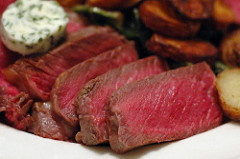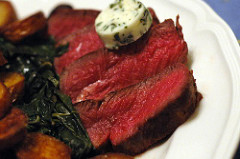What's Your Beef?

La Cense steak
Photo by Melissa Schneider.
How does a grass-fed cow's diet change the taste of the beef? Montana's La Cense offered to send me beef samples so that I could learn about grass-fed meat. I've already boarded that train, but I wanted to look at the effect of regional grasses on the flavor of the steak. Can beef reflect a place and a season the same way as wine, cheese, or honey? Grass-fed beef growers think so.
The La Cense steaks caused a stir when they arrived at the office. My co-workers are blasé about wine samples, but styrofoam boxes and ice packs still draw a crowd. The steaks and hamburger patties had a deep red color, and the leanness of the New York Strip was obvious: a thin strip of fat along the side, and an even but light marbling of fat in the meat itself. The pasture diet keeps the cows trim.
I knew what I wanted to taste next to the Montana beef: a Prather Ranch steak. Prather Ranch raises cattle near Mount Shasta, high up on the bicep of our arm-shaped state, and we often buy their beef (not only because it's good but because there's a stall at the Grand Lake farmer's market). The closest cut I could find was a filet mignon; I hoped for a tighter control, but the La Cense beef was ready to eat.

Prather Ranch steak
Photo by Melissa Schneider.
I treated the different steaks the same way: A light salting in the morning, another one in the evening, and then into a preheated sauté pan with a sizzle, where I cooked them to rare before letting them rest for five or six minutes under a foil tent. Standard Schneider steak treatment. I topped them with a tarragon butter, and put roast potatoes and braised chard on the side.
In the wine world, there is a debate about terroir, this sense of place I sought in the beef. How much of a wine's flavor comes from the soil and sunlight that nourished the vines, and how much comes from the craft of the wine maker?
A similar question lingered over our steaks. The Prather Ranch steak had a deep flavor—earthy and richly meaty—that the La Cense lacked. The Prather Ranch meat had a better grain (though that could have been the cut). They weren't just different, the Prather Ranch steak was noticeably better. (Though the La Cense was still better than standard beef.) Is this terroir or technique? The two farms use similar practices, including the all-important dry-aging time. But Prather Ranch finishes its cattle on grain (not corn), which creates a fatter meat. More fat means more flavor, even if the final product isn't as healthy as the La Cense beef. Which do you prefer?
Further reading: Amy's taste test, Meg's tasting note
- Bison Rib Roast
For a big celebratory meal, a rib roast is very impressive, especially with the bones in. While beef might be a common choice, bison is also available in a rib roast. I’ve shared my experience cooking several different cuts of bison and how much I enjoy...
- Chefs On Beef
When it comes to beef, the kind of you choose is truly a matter of taste and personal preference. There are different cuts, different preparations and of course different breeds. Me? I care about humane treatment of animals and healthy eating, but first...
- Learning About Certified Angus Beef
Julie Boggs of Westbrook AngusCertified Angus Beef is not the same as Angus or Black Angus which you may see on everything from beef at restaurants and supermarkets to even fast food burgers. In order to be designated Certified Angus Beef, it must pass...
- Delicious Omaha Steaks
Unless you are a vegetarian you will simply love this article. I will be talking about Omaha steaks. I hope you will enjoy it. If you have never had the opportunity of experiencing the savory taste and texture of an Omaha steaks, then you have never had...
- Casual Dinners
One of my un-New Year's resolutions is to come home early enough to have dinner once or twice a week. Most people assume that I come home and cook dinner every night, but in truth I get home so late, and I don't eat much anyway, that I usually...
